One of our favourite rooms in our home is our little office. It’s where I do most blog related work, but the thing I love most is that it allows me to peek down the street and have a nosy at what’s going on in the world around me.
And there’s one shock horror thing that I’ve been observing with dread over the last months – everyone seems to be having cavity wall insulation pumped into their houses. There have been at least 7 houses in the last week alone!
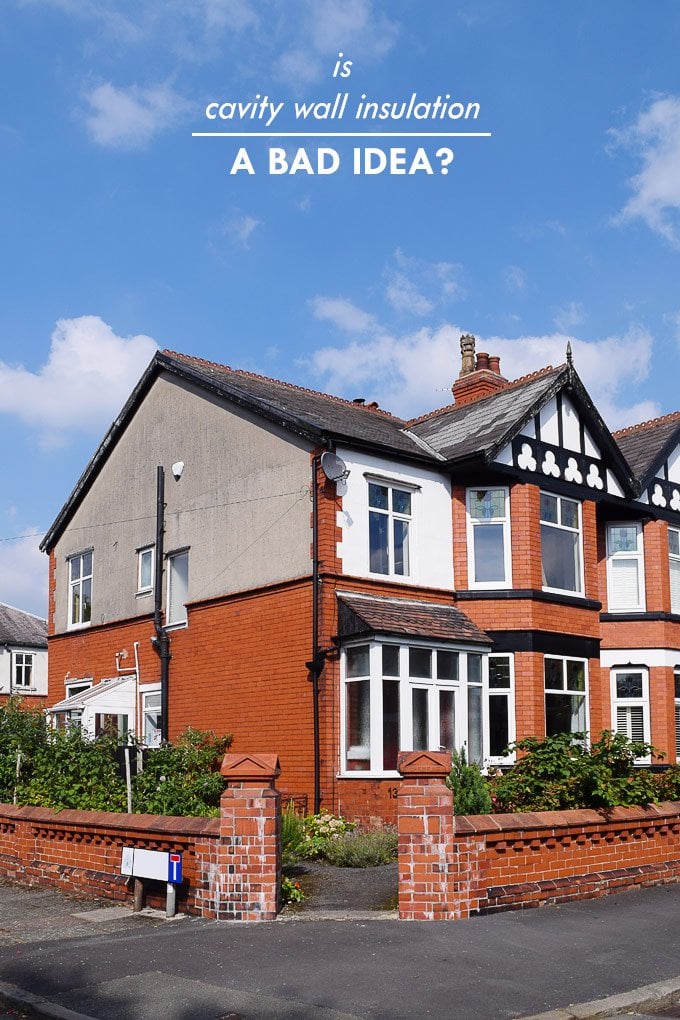
But isn’t it a good thing to be insulating your home I hear you shouting?
Well, yes and no.
We’ve insulated every possible last bit of our home – under the floors, the loft, pipes – you name it, we’ve done it, but there are areas where insulating your home is a bad idea that can cause you severe problems in the future. Retrofit cavity wall insulation is one of these problem areas.
So, what actually is cavity wall insulation?
Retrofit cavity wall insulation is essentially an insulating material that’s injected into the gap between the outer and inner brickwork layers of your external wall. Filling the gap with an insulating material is meant to reduce the amount of energy that you will lose through your walls.
How does insulating your walls work?
The company carrying out the work (this really isn’t a DIY job) turn up with a big van. Within a matter of a few hours, they’ve drilled a load of holes into the outer layer of your brickwork and pumped millions of little polystyrene balls (they’re actually called EPS balls) into the gap between the two brickwork layers. Then they fill the holes in your wall and are off again.
This is what the little balls look like.
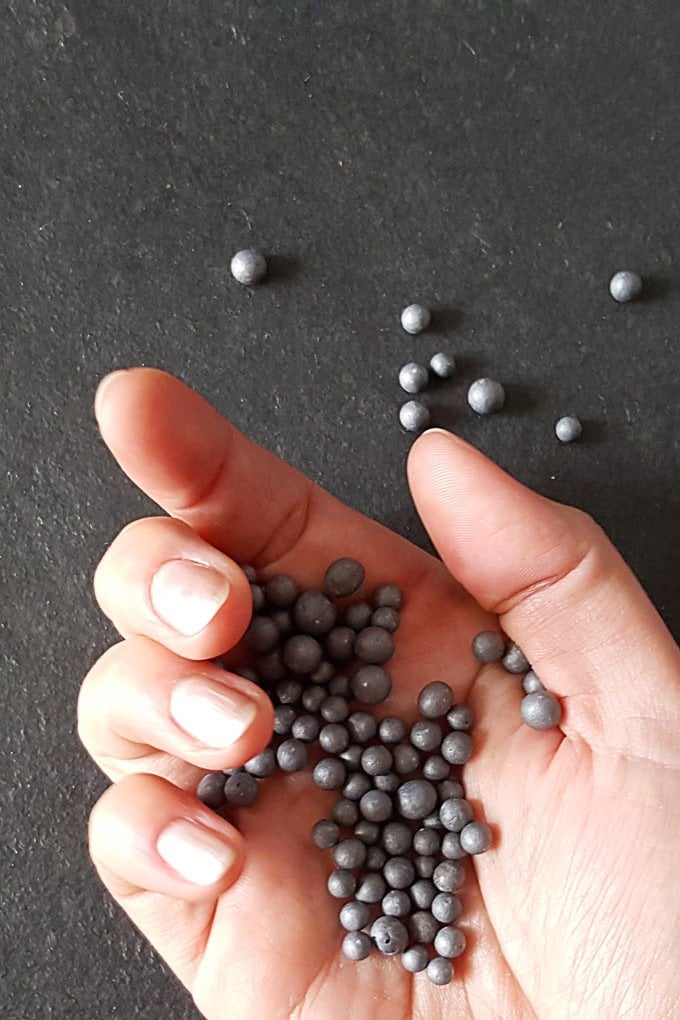
So why insulate everywhere else but not install cavity wall insulation?
Well, it’s simple really. By filling the gap between the two layers of brickwork you will inevitably create a bridge between the outer and inner layers and the gap is there for a reason! It creates a barrier between hot (inside your home) and cold (the outside temperature) and between the wet outside and dry inside of your home.
If water enters the gap, it’ll run down the outer layer of your brickwork and dry out (which is why airbricks are important). If you have retrofit cavity wall insulation the water should run down through the non-absorbent insulation balls and out at the bottom. That’s the idea anyway.
In reality, especially if you live somewhere as wet as we do, that may not always be possible. If it’s wet and windy, the exposure to rain may not give the cavity time to dry and therefore the moisture could transfer to the inner wall and into your home.
Also, the installers are essentially blind as to how they’re filling the gap. Yes, the do drill a lot of holes and pump in the insulating balls till the gap seems full, but it may not be completely full and you may be left with pockets in your wall where there’s no insulation!
Not only does this not help you keep in the heat, it can also cause a thermal bridge which is essentially a weak spot in the insulation that allows hot and cold air to meet. The big difference in temperature that’s created through the bridge will cause condensation and could therefore also result in damp issues.
Overall it’s something that I personally wouldn’t do – ever, but especially if (like us) you have a cavity that’s less than 5cm wide – don’t do it!
That’s of course not to say that the technology won’t change in the future, but at the moment it’s just worth the risk to us.
I would even go so far as to say that I would consider not buying a house that has retrofit cavity wall insulation. I know that this sounds extreme, especially when you consider the state our home was in when we bought it, but for us, it just comes with too many risks and is too difficult to put right.
What if I’ve already had retrofit cavity wall insulation installed?
If you’ve already had retrofit cavity wall insulation fitted, you could consider having your house surveyed with an infrared camera. It’ll allow you to see if the insulation is evenly distributed throughout the wall and at least help you determine if you have any gaps that will need filling to avoid thermal bridging problems.
We’d also recommend checking your pointing and gullys to make sure that everything is well maintained and therefore hopefully avoiding any penetrating moisture as far as possible.
If you’re already having issues with cavity wall insulation or would like advice you can check out the cavity wall insulation website.
This, of course, isn’t the case for every house with retrofit cavity wall insulation and you may never have problems, but if you do decide to have cavity wall insulation installed and start to experience condensation, damp or mould don’t say we didn’t warn you! Overall be careful and do your research!
Do you have cavity wall insulation? We’d love to know if you do and if you’re happy with it or if you’ve encountered any problems!
PS. I just came across this article in the Telegraph that covers possible issues with retrofit cavity wall insulation.

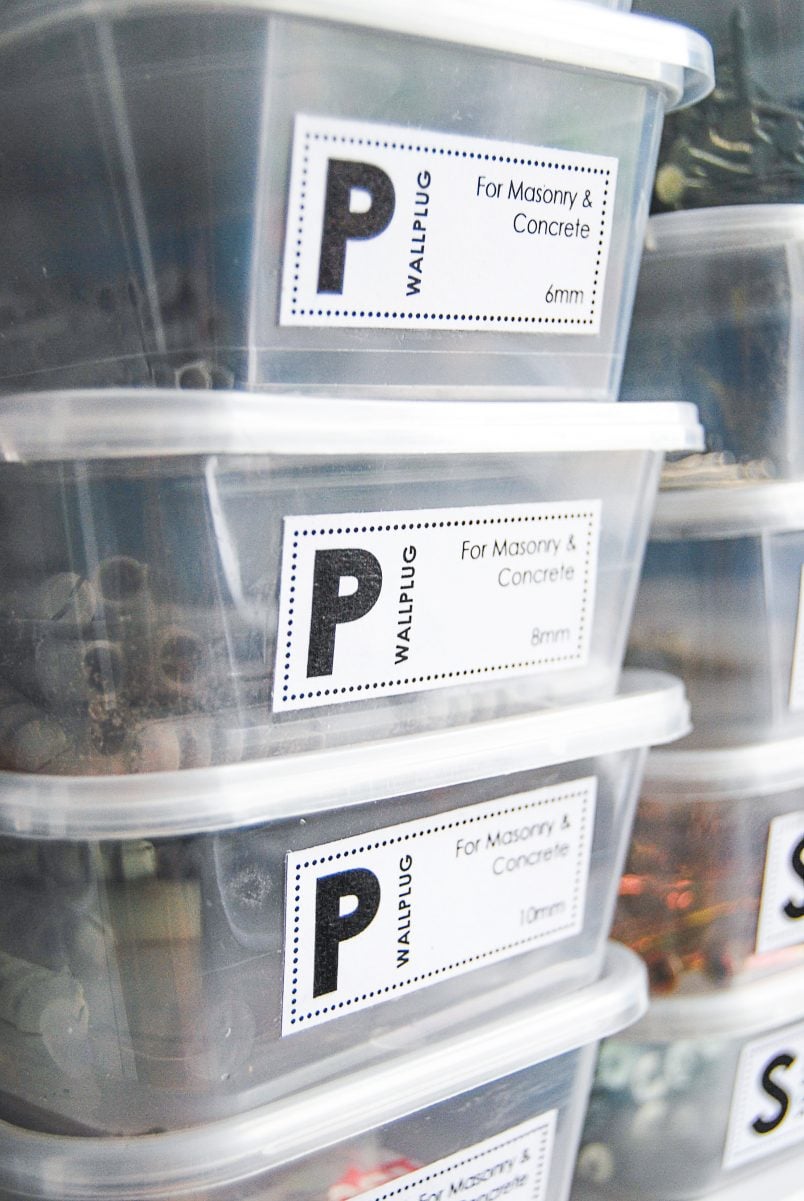
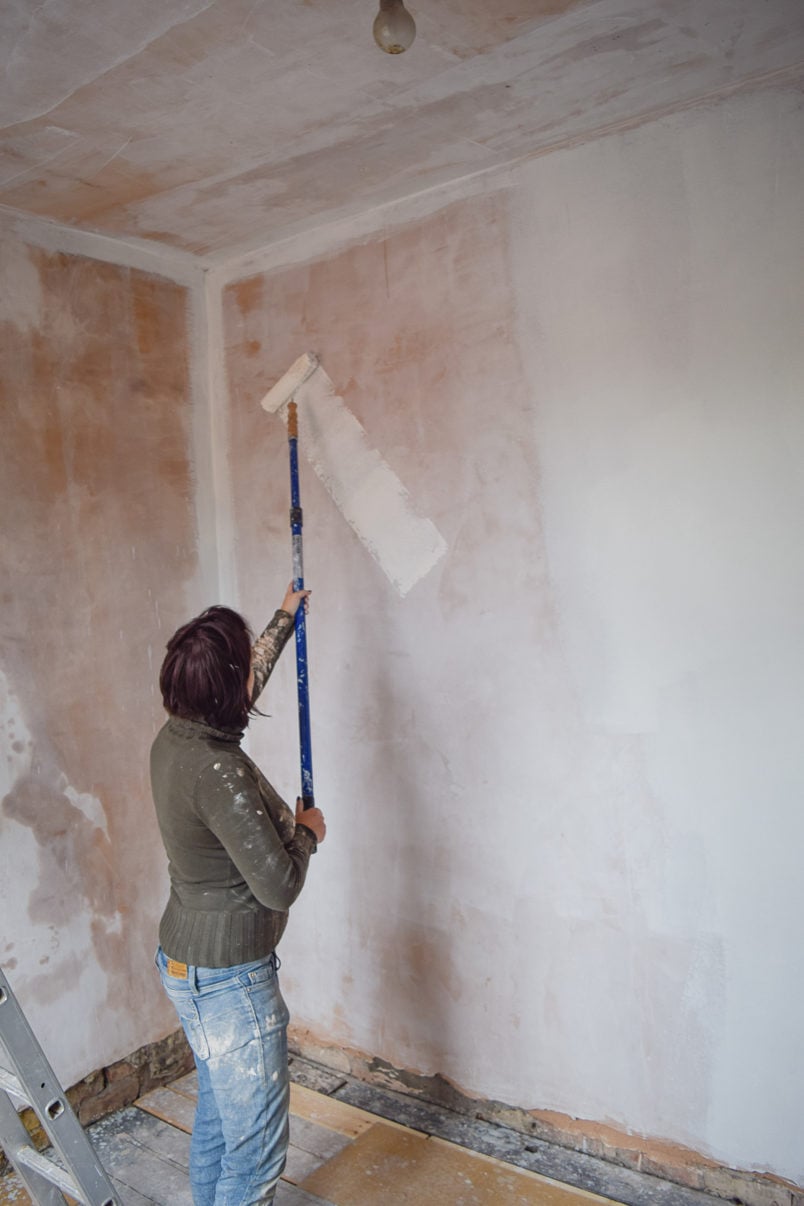
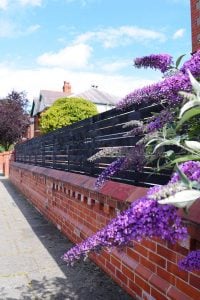
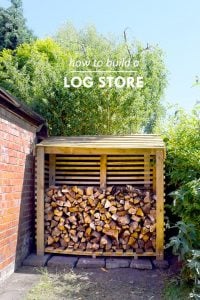

Corinne Jones says
As I’m writing this we are having our cavity wall insulation taken our 6hrs in so far, can’t wait for it to be gone, our house can’t breathe the walls in two of the bedrooms have water dripping down them, the ceiling in one of them has globules of water in spots, I’ve constantly washed treated and repainted, if I don’t the mould grows, windows are drenched every morning too, the kitchen gets mould on the wall too, the wall feels wet as well… am truly looking gizzard to not having insulation ever again! We are semi detached so plenty of wall space to be treated, apparently we weren’t even compatible to have it done, as we have some from and rear timber framing on the house, it should never have been done hoping this is the way forward for us!
Christine says
Oh wow, that sounds like an absolute nightmare, Corinne! Thanks for sharing your experience and we’re keeping our fingers crossed for you that removing the cavity wall insulation helps solve the problems.
Cx
Umar Farooq says
We just bought the house in summer with cavity wall insulation. It’s a nightmare fir us all house is dump and water literally running bottom of wall. Every thing get damp and wet. All card boxes are damping in the house. We don’t know how to solve this issue.
Christine says
That sounds awful, Umar! So sorry to hear that you have such problems. I’d definitely get a surveyor in to check where the problem is coming from and see if they can give you advice on how to solve the problem. Keeping my fingers crossed for you that you manage to get the issue solved quickly.
Cx
Ann says
We have a rental property that has been let for 12 years with no issues until we has CWI installed about 5 years ago, now over the last 2 years we have started with condensation problems. The original report from CIGA suggested we remove it due to voids and debris in the cavity but they insisted us on having new air bricks fitted, 12 months on we have still got mould issues so now I have requested it all be removed, it is the wool fibre CWI.
Christine says
Thanks for sharing your experience, Ann! That’s so annoying! Hopefully, all of your condensation and mould issues will be resolved when it’s removed.
Cx
Jeff Tilton says
I just heard of CWI and searched it and found this site. Here in Canada all our homes are built with glass fibre in the walls and newer homes have foam on the outside as well. It’s -30C outside today but a comfortable 21C inside. I looked this up as I was surprised any homes were built without insulation.
I’m confused by some comments suggesting folk turn off their heat and only turn it on when they get home. We turn our heating systems on in October and don’t turn them off until the start of May. If you turn them on and off the walls will be really cold and take a long time to warm up again.
Also, put insulation in your attic. I increased mine to 1M thick (blown fibreglass) and it has made a huge improvement.
Christine says
This post is only referring to retrofit cavity wall insulation on old buildings like ours which was over 100 years old. All new homes are, of course, built with necessary insulation! I totally agree with you about insulating your attic, Jeff. We insulated every other part of our home (loft, under the floors, new windows, etc) but when it comes to cavity wall insulation in older properties it’s worth doing your research as it may not be the right thing to do for every property.
Cx
Jim Jamieson says
100 year old houses didn’t have cavities. Are you sure you know what you’re talking about?
Christine says
What can I say, we had ours checked and it did. Many of our neighbours in identical houses also had cavity wall insulation installed which obviously wouldn’t have been possible if they didn’t have a cavity. We’ve since moved and our current house which is over 120 years old also has a cavity. Are you sure you know what you’re talking about? :)
Cx
James says
Thanks for this! Found it really REALLY helpful. We’ve been thinking about it for a while, but something has been holding me back. Our youngest has quite sever asthma and we really didn’t want to do something that could potentially introduce damp into the house! So thanks a bundle for your insight. Love the blog. James form honesthouse.wordpress.com
Christine says
Glad we were able to help, James! We insulated every bit of our home possible but are so glad that we didn’t mess around with the walls. Technologie is always improving so hopefully there will be a solution that really works, soon!
Off to check out your blog…
Cx
Ed says
Interesting article. I’ve just bought a detached bungalow that isn’t very warm despite a new combi boiler and radiator. The answer, I’ve been told is cavity wall insulation. So I’ve done some reading. Yesterday I concluded that the one with the polystyrene balls is the way to go. In the advert on Youtube, the water just pours to the bottom. Then I read what you’ve put and now considering alternatives.
I had “rising damp” as it’s known in my previous house and endured the so-called remedial work, just so I could get the house sold. It’s not remedial at all. It’s a scam but that’s another conversation.
In the meantime I’ll be looking into a less invasive way of keeping the cold out.
Christine says
At the end of the day, the theory is kind of right and the water should run through the balls and down to the ground but in reality, it’s probably different. You cavity walls will be full of bits of mortar and dirt which will inevitably start to settle and over time fill the gaps between the balls that water is meant to run through.
It’s a difficult decision, Ed. I’d probably recommend having an independent survey carried out by someone who knows they’re stuff and not someone who wants to sell you insulation.
Good luck!
Cx
Brian says
Yes I’ve seen it applied in cavity’s where you could nearly see through into the house, being by the sea, I was shocked at the condition of the pointing. Luckily haven’t seen such a bad install for years.
Brian says
I’ve had my cavity filled on top of the insulation boards that where installed on the initial build in 2000. I am well aware of its blocking capabilities for heat retention and draft proofing for when you’ve warmed up your house. The blocking effect works both ways and we where unaware of how much free heat we where gaining from our South facing elevation, even in the winter. In the summer we gain a welcoming super cool house, in the winter, spring and Autumn, we gain a morgue of a house, it’s been mentioned by visitors to the house within four feet of entry, more than once. I get asked if I am just leaving, regularly as I answer the door, reality is I wear a coat from the minute I put the kettle on, and sometimes a hat, and that was never the case previously. We are finding we are putting the heating on as soon as we get home and regularly checking to see if it’s working as it never warms up before bedtime on some days , even in April, which was never the case previously either. Oddly I am expecting an increase in gas use, and a smart meter isn’t going to help. The morgue effect was mentioned by residents of some South facing solid wall houses in Plymouth recently that had received EWI, most would have it removed if it was possible. And the coldness of the house was the reason. No I said it’s not the Insulation that warms your house up it’s the heating, but we never used our heating before, she said. For the fuel poor the free sunshine was a welcoming start to the day. Insulation for some isn’t a welcomed addition.
Christine says
I guess it goes to show that insulation is a complicated subject. It can be right in a lot of situations but it’s just not always suitable. Hopefully, insulation methods will be further improved so that there’s a solution available for everyone.
Cx
Dan Gravell says
It’s not really that complicated, it’s GCSE physics. Anybody can model this with a tool like PHPP.
OP is probably mistaken. It’s highly unlikely that the heat gain from the sun in the colder months counteracts the heat loss from not having the insulation. There will be some other problem.
There is no case I have ever heard of where “insulation… [is] not always suitable”. It’s an integral part of the fabric of a house.
Neil says
You said that the initial build of the house had insulation boards installed in the partially filled cavity. Surely this would’ve also blocked this natural heating effect. This extra insulation must be a god send, during the colder winter months. Why don’t you install some other passive form of heating, to harness this free heating effect from the sun?
I’ve also heard horror stories of the polystyrene beads and blown wool cavity wall insulation. Where they become saturated with moisture, causing untold damage and problems.
There doesn’t seem to be any control or guidance from any government run institution. Where you can go to get positive/constructive information/guidance. Who will offer the help and support in resolving issues, when things go wrong. Instead we’ve been left to the greedy sharks(salesmen), who take your money and run. Who make it virtually impossible, to get things fixed, if things do go wrong.
Nobody’s mentioned the two part (closed cell), polyurethane expanding foam, cavity wall insulation. Which seems to offer a solution, to all the problems, experienced by the other types of cavity wall insulation. Why doesn’t the government take control of this matter, of insulating homes. They’re the ones who’ve been given the carbon reduction targets. So why don’t they coming up with proper, permanent solutions to these problems.
Brian says
My house was built for shareholders, not for me. Houses built to a tight budget for Social housing. My EPC noted my broken window and all the steamed up ones and the gap under the front door, has housing been round yet, no. My windows are on a 30 year replacement cycle apparently. My boiler is quite new, after my old one ejected boiling water out of a valve on the top for two years, blowing the Artex off the ceiling. Partnering contracts seem to run out of money quite early in the contract, hence the wait for a new one, had to wait for a new contractor to take over. My new boiler has an Eco mode, which means it doesn’t keep a small bit of water hot for your immediate use, but still seems to fire the boiler and run the fan for a few minutes, every half an hour, as such it’s turned off until I use it, which isn’t everyday. My downstairs loo window ejects around 100 poly beads every time its windy from the trickle vent. The original insulating boards did nothing for the draft proofing as my bath panel would frequently blow off, it doesn’t any more, suggesting to me the system wasn’t up to much thermal wise previously.
Why don’t we all make more use of the free sun, instead we do our best to block it out and have to heat our houses at a cost. If we could turn the suns effects on and off at a whim, it would be a much cheaper and greener world.
I feel for all those I’ve visited over the past few years for a boiler replacement with external insulation, quite a number had never used their old boiler, some had no idea where it was, I bet they do now after being Insulated as well.
Neil says
So are you saying, that the way the original uninsulated, draughty house, didn’t required the central heating to be on the majority of the year?
Brian says
No I’m not as I’ve been asked if I was freezing many times, as a precursor to putting the heating on by my kids. My house had 600mm sheets of some form of Insulation in the cavity, maybe 40mm thick. It was obviously badly fitted by the bricklayers. The house is a good example of what can be achieved with tight prices for the workers and cheap materials.
Residents of solid wall houses have been complaining the most where the effect is more noticeable with the loss of direct and ambient heat, plus those in solid wall terraced houses. Some in the solid wall terraces asked for insulation on the back North facing elevation only, when told it wasn’t possible under the Green Deal they opted out.
My gas bill says I’m an average user for someone who uses gas for cooking and heating, yet it is rarely on all day except during our two week winter holiday. When my windows are changed in the year 2030 I am expecting even more free heat to be deprived of. It is by no way a lose, lose situation for me. Recently acquired cool nights in the summer are most welcome.
Local new builds have a much smaller set of windows on the South facing elevation suggesting it is government policy.
Brian says
I have downloaded my gas usage for the last five years in my quest to prove the Insulation is a saving addition to the fabric, and have some figures in my head as facts. Our gas usage has gone from 10,502 KWh to 4,344 KWh over a five year period. The biggest fall when the insulation was fitted was 2,500 KWh. Our electric over the same period has also fallen by 3,000KWH. Energy saving bulbs and turning off the pond helped.
Daniel Gravell says
Well done for measuring. Measuring always trumps folksy wisdom.
The other major, major thing is air permeability.
Julius says
Hey, nice article, but i think it’s very depend of where in the planet you live and what is the air ,temperature and other conditions in my climet where the winter is cold and summer is heating, my neighbours are very pleased with air insulation, but before do it I would advise with non commercial specialist adviser which I will pay not for insulation but for advise and I think he will advise me better.
Christine says
I totally agree with you, Julius. Any home improvements will always depend on your personal circumstances and things like how your home is constructed, where it is, etc. Getting a second opinion is always a good idea, especially if it’s of someone who is impartial.
Cx
Gary says
I have just had a cold call from a company rep offering free cavity wall insulation. He left me with an appointment for a survey on Monday. All very quick. I am glad I found your blog. I will ring them tomorrow and cancel. My house was built in 1994 and has thermocline blocks so not sure insulation would make much difference.
Christine says
It’s always difficult to know what the best thing to do is for your house, Gary! It really all depends on the way your house was built and how large the cavity is – having said that I’d be very wary. I think that the idea of cavity wall idea is a good one, I just don’t think it’s at the stage where it’s suitable for most homes – yet. Hopefully things will improve in the future.
Cx
Wendy says
Hi, I’ve just moved I to a rentedbungalow without cavity wall Insulation and within 3 weeks we’ve had black mould walls in the east wall
From floor to about 3 feet up. Also south wall up to 12 inches. Also in kitchen. Help! We have a dehumidifier running 24/7 and our humidity is running at 40%.
The landlord is refusing to get cavity wall insulation (maybe wisely given the thread above). What can we do????
Christine says
Oh no, that sounds like you have a real problem, Wendy! I’d say that you need to work out why the mould is developing and where the issues in the house are. Often, it’s something little that causes big problems. That being said, black mould can cause serious health issues so it’s probably something you should get checked by a professional. In the meantime, all that I can recommend is clean the wall with a mould remover (obviously wear protective gear) and ventilate the room regularly.
Hope you manage to get it resolved quickly!
Cx
Rebecca says
So technically, it’s not really advised for it to be done? Then why is a service that is being offered? Maybe you said something about it being situational (May have skipped it) but if it’s not really advised, why would people have it installed or why would there be people offering a service to install it in the first place.
Christine says
It does depend on the situation, Rebecca, but in general it’s more often a bad idea than a good one (partly because it’s often badly installed, too). There are always new things coming out that people think are a good idea but soon learn that there are drawbacks. After all, there was a time when everyone thought that asbestos was a good idea, too.
Our neighbours that had the cavity wall insulation installed about a year ago area already experiencing damp problems which they’d never had in the 15 years of living there before.
Cx
Rebecca says
That’s really unfortunate. I was almost talked into having it installed in my home too, good thing I read a few blog posts about it, like the one you made.
Christine says
Like I said, it’s not necessarily always a bad idea but in a lot of cases it’s not suitable and just not worth the risk.
Cx
Phil Beynon says
Recent (2016) BBA-NHBC research showed that even under ‘laboratory conditions’ for building a wall (amazingly with a window) and installing mineral fibre insulation in a 100mm wide cavity that without any construction defects that damaging amounts of water penetration occurred within days. It appears that the failure was such that the mineral fibre industry elected to halt any further tests mineral fibre. All other tested systems passed the window test.
It appears that if your house has Windows, it should. Not. Have mineral fibre CWI. Installed.
As CIGA say, a certified system in a suitable property that is correctly installed to a high standard. should perform correctly. Unfortunately, it appears that few MF installations now meet these basic requirements.
Kenny says
I was interested in the research you quoted so tried to dig it up:
Results of the tests were:
– All three of the built-in materials completed the test with no rain penetration occurring during the three-week period.
– The blown-in expanded polystyrene (EPS) beads also completed the test, although a temporary minor damp patch was observed on the ‘inner leaf’ of the test wall at one stage.
– In the case of the blown-in mineral wool (MW), water penetration was observed during the course of the test.
So the summary appears to be that mineral wool might not be a good idea, but EPS beads appear to be ok.
Peter Chisnall says
I don’t agree. Cavity Wall Insulation is a sensible way to insulate the walls of a cavity walled house provided the house is right for it and it is installed correctly.
That’s what this group should be pushing, not a blanket statement as above. If a house is in a certain part of the country prone to prevailing south westerly winds that drive rain onto the walls, or it is in a coastal or exposed area then it should not have fibrous or blown foam ball insulation.
Tha installer should ensure that the cavities are suitable and clear of any rubbish and mortar projections that will not cause bridging when the insulation is installed. Ideally when any insulation is installed, external, internal or cavity the walls should be modelled using proper hygrothermic simulation to see how moisture travels through walls,
The group should be pushing for proper policing and regulation of the CWI industry!
I say that from being in the position of a house with cavity walls in a flood plain incorrectly installed with fibre insulation. It should be a closed cell foam insulation like Isothane. I am battling with CIGA to get it replaced.
Christine says
Thanks for the feedback, Peter. I agree that cavity wall can be sensible in the right houses and if it’s installed correctly, but currently there seems to be no real regulation and installers seem to be doing what they want where they want without necessary checks or prep work. I totally agree that there needs to be a proper policy and official guidelines, too. Insulating your home is something we should all be doing – it just has to be the right method with the right materials for the job.
Cx
John Barrett says
Good luck with your battle, I have personally been involved with four houses which have had blown fibre fitted, and one with Celotex external cladding and render fitted. ALL these houses now suffer from very bad damp and mould, and BRITISH GAS are trying to wash their hands of the problems their chosen contractors have created. ANYONE with any common sense on seeing where these houses are situated would know that these systems were going to be a liability, but NOT the “surveyor” that recommended these systems for those houses. There is hopefully going to be a court case shortly, where things should become clear….
Dan Gravell says
Sorry, but without expanding on some of that detail you cannot come to any kind of evaluation of the situation.
What I would say is that bad policy; government attempting to hit targets in the cheapest possible manner; has led to bad design. But we mustn’t say “insulation is bad” as a result. The fix is to consider each house individually.
I would generally advise people to use someone that knows a bit about building physics to advise OR learn it yourself – the basics (to help you weed out the snake oil salesmen) are easy to understand – GCSE level physics. The overwhelming majority of builders and architects do not, however, seem to understand it. For example – celotex EWI??? I assume this was a millionaire’s house or it was somewhere with very high house prices. Barmy decision.
brian lee says
In the 80’s I applied EWI to some exposed houses around the South West coast as a test. They were all Glass Wool, as FR foams hadn’t arrived. You will find my name on the Government’s White paper on best practice for solid wall insulation, The fix is to consider each house individually, indeed. My son is still in the trade and over the last ten years has had constant arguments with Sales and Management about basic science and system specifications.
In Bristol we had £300 noted as the cost for scaffold on the contract. For most of the properties this wasn’t enough money, it might not include a ladder or in worst cases the scaffold didn’t reach where you needed to go. The Scaffolder refused to add anymore tube in, without anymore money, but the spreadsheet was stuck on £300. Health and safety took a dive as workers had to climb outside the scaffold to render to the end of the wall. Amazingly I saw the same again on a huge site for a large Construction company in Bristol some years later, men outside the scaffold, reaching. With that sort of mentality it’s easy to see some damp walls or in Grenfell’s case, death. Business is corruptible, given the chance.
Celotex EWI? I see PL4000 indoors regularly, especially in timber frame and dabbed onto block walls with a plasterboard finish but have never seen it outside.
CIVALLI says
Wise advice! We deal with terrible cases of damp following the installation of cavity wall insulation. The redress systems are inadequate.
mike vessey says
I’m surprised that you have a cavity at all in an Edwardian house! But now, looking at the photo of your brickwork I see it has a cavity.
Our house looks the same as yours but is single brick all the way. Cavity walls only really started to become widely used in the late 20s and early 30s. Yours must have been an unusually high-spec home when it was built.
Christine says
I’d never really thought about it being unusal Mike. Most of the houses in the area seem to have one. Our house is late Edwardian, so maybe that’s when they started to build cavities more frequently. I don’t think ours was particularly high spec – or at least if it was, there was nothing left of it when we bought it! ;(
Cx
Saskia says
Wow that is a very interesting article! I have also always said that it is not for us. I researched it for so long when we moved into our house and found that it’s best to leave the house as these houses are not build to be air tight like that. They need to breathe.
In our neighbourhood people are wrapping their houses up. I have seen about 20 houses being clad in some polystyrene brick like layer which is then plastered. The strange thing also is that in a row of terraced houses it looks so out of place to have a plastered house. It completely looses it’s character.
Christine says
I guess every home improvement and change that people make to “improve” their home should always include a bit of research beforehand. We often spend more time planning and researching projects than actually doing them! ;)
Adding an insulating layer to the outside of your house is a much better way of insulating your home, but I totally agree with you that it looks weird – especially in a row of terraced houses! We always knew that there would be drawbacks to living in a 100 year old home, but for us the pros like the high ceilings and character you mentioned outweigh the cons like being cold in winter.
Cx
Mary says
I’ve had countless salesman at my door trying to sell me cavity wall insulation, I’ve always declined.
Because I’m a woman they made me feel as though I don’t know what I’m talking about. One guy I remember, said ” all your neighbours have had it done” and “we do a test drill first, they’ll be no mess”
I Know exactly how it works, I replied, but I don’t want it doing, as I told him the houses need to breath and that is why there is a gap between the walls. He went on to tell me, well when these houses were built, it was just after the world war 2 and they didn’t have the resources so that is why the gap was left.
I told him to go and do his research as these houses were built in 1936, 3 years before the war.
He wasn’t too pleased, then left.
Christine says
Haha, I guess you really put him in his place. ;) At the end of the day, most salespeople don’t care about your house all they’re bothered about is selling something. We had the same situation where people would tell us that everyone in the street had insulation so we needed it, too. You’d at least think they’d get their facts right about when the houses were built, though…
Cx